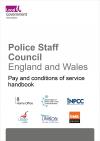1. Title
The Police Staff Council (referred to as “the Council”).
2. Scope
The scope of the Council shall relate to staff who are employees of Police & Crime Commissioners and Chief Constables in England and Wales, who are subject to the direction and control of a Chief Constable or Police and Crime Commissioner.
3. Membership
3.1 The Council shall consist of fourteen members, seven known as the Employers’ Side and seven as the Trade Union Side.
3.2 The seven representatives of the Employers’ Side shall be appointed as follows:
| Association of Police and Crime Commissioners (APCC) |
4 |
| National Police Chiefs’ Council (NPCC) |
2 |
| Home Office |
1 |
3.3 The seven representatives of the Trade Union side shall be appointed as follows:
3.4 If any of the appointing bodies fail to appoint the number of representatives provided for by the Constitution, this shall not invalidate the decisions of the Council.
3.5 The appointing organisations may appoint substitute members to attend meetings in the absence of their appointed representatives.
4. Purpose
The purpose of the Council is to:
4.1 Negotiate
National agreements on the pay and conditions of service of employees within scope of the Council.
4.2 Consider
4.2.1 advice to the Home Secretary on general questions affecting police staff in England and Wales (excluding the Metropolitan Police).
4.2.2 draft regulations which affect police staff that the Home Secretary proposes to make with respect to matters other than those covered by 4.1 above.
4.2.3 any matter affecting police staff which has been referred to it by the Home Secretary and any of the constituent organisations.
4.2.4 advice on and interpretations of national agreements.
4.3 Consult
On issues of mutual interest and to report on such matters to the constituent organisations.
4.4 Resolve Disputes
By assisting the employers and recognised trade union representatives of their employees in resolving differences where the local parties jointly request assistance. Initially the Joint Secretaries of the Council will discuss the matter with the local parties.
5. Conduct of business
5.1 At its annual meeting the Council shall appoint a Chair and Vice-Chair. When the Chair is a member of the Employers’ Side the Vice Chair will be a member of the Trade Union Side. The Chair and Vice-Chair shall be held in alternate years by a member of the Employers’ Side and a member of the Trade Union Side.
5.2 At its annual meeting the Council shall appoint two Joint Secretaries.
5.2.1 the Employers’ Side Secretary will be an officer of the Local Government Association;
5.2.2 the Trade Union Side Secretary will be an officer of UNISON.
5.3 Ordinary meetings shall be held as often as necessary, notice of which shall be provided to members at least seven days in advance of the date of the meeting. The Joint Secretaries shall call a special meeting of the Council if requested by four members or all of the representatives of one of the constituent organisations. A special meeting shall be held within fourteen days of receipt of the request to hold it and the notice summoning members to a special meeting shall state the purpose for which it has been called.
5.4 The quorum of the Council shall be eight members divided equally between the Employers’ and Trade Union Sides provided that the constituent organisations of the Employers’ Side (see paragraph 3.2 above) are represented at the meetings. In the absence of a quorum, business shall finish and the matter then under consideration shall be the first business to be discussed at the next meeting.
5.5 The Council can co-opt non-voting members for specific purposes and may set up sub-committees and working parties as it considers appropriate. Any such sub-committees or working parties shall report to the Council.
5.6 The administrative expenses of the Council shall be divided equally between the Employers’ and Trade Union Sides.
6. Resolution of disputes
The constituent organisations are committed to avoiding disruption to the police service. National disputes will be resolved whenever possible by negotiation, conciliation, or arbitration. Either Side of the Council may refer a failure to agree on a subject that is covered by paragraph 4.1 above to the Advisory Conciliation and Arbitration Service (ACAS) for settlement by arbitration.
7. Amendments to the constitution
The Constitution may be amended with the agreement of all the organisations referred to in paragraphs 3.2 and 3.3 above.


